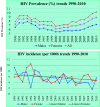The general population cohort in rural south-western Uganda: a platform for communicable and non-communicable disease studies
- PMID: 23364209
- PMCID: PMC3600628
- DOI: 10.1093/ije/dys234
The general population cohort in rural south-western Uganda: a platform for communicable and non-communicable disease studies
Abstract
The General Population Cohort (GPC) was set up in 1989 to examine trends in HIV prevalence and incidence, and their determinants in rural south-western Uganda. Recently, the research questions have included the epidemiology and genetics of communicable and non-communicable diseases (NCDs) to address the limited data on the burden and risk factors for NCDs in sub-Saharan Africa. The cohort comprises all residents (52% aged ≥13years, men and women in equal proportions) within one-half of a rural sub-county, residing in scattered houses, and largely farmers of three major ethnic groups. Data collected through annual surveys include; mapping for spatial analysis and participant location; census for individual socio-demographic and household socioeconomic status assessment; and a medical survey for health, lifestyle and biophysical and blood measurements to ascertain disease outcomes and risk factors for selected participants. This cohort offers a rich platform to investigate the interplay between communicable diseases and NCDs. There is robust infrastructure for data management, sample processing and storage, and diverse expertise in epidemiology, social and basic sciences. For any data access enquiries you may contact the director, MRC/UVRI, Uganda Research Unit on AIDS by email to mrc@mrcuganda.org or the corresponding author.
Figures
References
-
- World Health Organization. Global Burden of Disease Projections, 2009. http://www.who.int/healthinfo/global_burden_disease/projections/en/index... (31 August 2011, date last accessed)
-
- Maher D, Sekajugo J, Harries AD, Grosskurth H. Research needs for an improved primary care response to chronic non-communicable diseases in Africa. Trop Med Int Health. 2010;15:176–81. - PubMed
-
- Brown TT, Cole SR, Li X, Kingsley LA, et al. Antiretroviral therapy and the prevalence and incidence of diabetes mellitus in the multicenter AIDS cohort study. Arch Intern Med. 2005;165:1179–84. - PubMed
Publication types
MeSH terms
Grants and funding
LinkOut - more resources
Full Text Sources
Other Literature Sources
Medical




